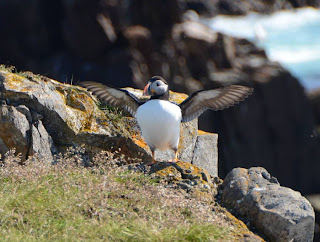Looking over to Norris Point, near Gros Morne National Park.
The view from Neddies Harbour Inn, Norris Point.
Typical wooden buildings along the shoreline.
As one drives along the road in Newfoundland, you see lots of these vegetable gardens. They are sometimes many kilometres from a settlement. The fence is to keep the moose out and they are sited where the ground is neither boggy nor stony.
The other common sight along the road is wood heaps.
Thursday morning dawned bright and sunny and so it was a pleasant drive up to L'Anse aux Meadows near the Northern tip of Newfoundland, stopping only to buy a bottle of wine and a small bottle of Screech, the Newfoundland traditional drink, which is actually rebottled and renamed Jamaican rum.
Map showing the probable route taken by the Vikings from Greenland to Newfoundland in 1000 A.D.
Modern Vikings enjoying lunch of fish and bread porridge.
A Viking loom. I am not an expert in weaving, but I was intrigued to see the weaver worked from the top down rather than from the bottom to the top.
Today Parks Canada have built replicas of some of the buildings and have modern Vikings enthusiastically recreating the past. We easily filled in 2 hours until we had to be at the dock to catch the boat to Quirpon Island where we were staying in the lighthouse keeper's cottage. It is only a short boat ride and on the way we had a close inspection of an iceberg. We were fortunate the sea was calm and we were able to land close to the lighthouse. Sometimes people have to walk the 5 km from the opposite end of the island.
Approaching Quirpon Island.
Cape Bauld Lighthouse, Quirpon Island.
We thought it appropriate to sit on the verandah sipping our Screech (Cooled with 10,000 year old iceberg ice), watching the resident icebergs and trying to spot whales.
View from the verandah of the Lighthouse keeper's house at Cape Bauld, Quirpon Island.
What we were drinking as we sat on the verandah.
After a very hot night due to the overheated building, we were surprised when we looked out the window in the morning to see an iceberg had drifted into view!
As we were there only one night we did not have time to explore the island. The weather held and we were able to leave from the landing near the house. Bryce, the boatman not only took us close by a large (by Newfoundland standards) iceberg. The visible portion was about the size of an aircraft carrier. We also saw a seal relaxing on an iceflow and a humpbacked whale performed for us.
Wildflowers on Quirpon Island.
More wildflowers.
Loading our backpacks onto the boat for our return to the mainland.
A humpback whale shows off his tail.
Getting close and personal with an iceberg.
Main Brook our next overnight stay was not far away, so we went to Conche. Like many places in Newfoundland there was no road in until 1969 and even now it is unsealed. Now fishing is more problematic, the community was looking for alternative sources of income. This area is on the French Shore, so called because from 1713 until 1904, only the French could fish these waters. They were not allowed to settle and returned home to France every winter. So a French artist designed an equivalent of the Bayeux tapestry and 13 local ladies embroidered it. It tells the story of the area with much humour and great little details. e.g. Confederation with Canada in 1949 is represented by a Canadian beaver and a Newfoundland dog shaking paws.
Although no photos are permitted of the actual French Shore Tapestry this extra panel was embroidered by local school children.
A partly embroidered panel. The tapestry is on 16 inches wide natural linen and is 222 feet long. The colours of wool used are the same as in the Bayeux tapestry. Twelve local women sat around a wooden frame and embroidered working from sketches sent from the artist in France. It is a most impressive work of art, but Conche is out of the way, so it will be difficult to put it on the tourist trail.
Saturday was showery, but improved over the morning and as we had to return south by the same road we had driven north on, we decided to try our luck again at Western Brook pond and walked in again. The photos below taken during the two hour boat ride will show why I thought the 12 kms of walk worth it!
Western Brook Pond. Fortunately the mist was almost clear of the top of the gorge.
One of many falls at Western Brook Pond.
The tin man face.
Now suddenly it was our last day. We had stayed in Corner Brook and thought we should find the Captain Cook monument before we left. Our GPS has given up the ghost and the streets were often one way and unnamed, but we eventually found it.
Glynmill Inn, Corner Brook - built in 1924 as an executive guest house during the construction of the pulp and paper mill.
Inscription on the Cook Memorial. It records that his good work in Newfoundland helped him to win the commission to explore in the Pacjfic.
The last excursion was to Big Falls to see the salmon leaping. It was not in the tourist literature, but a Canadian at breakfast had recommended it. There was 16 km of pot holed gravel to get there, but we did see some fish trying to leap the Falls which made it worthwhile. Apparently last week was much better before all the recent rain raised the river level.
Big Falls. We did see a few brave salmon try to leap up, but we did not see any succeed.
This is my last post as we are now back in Australia after an interesting and enjoyable holiday.

































































